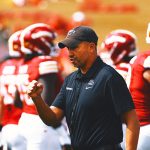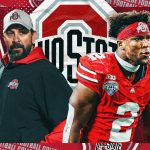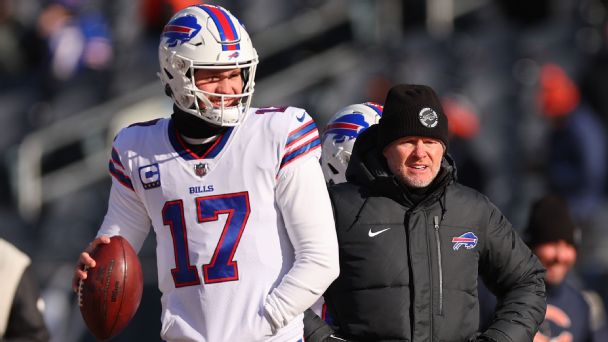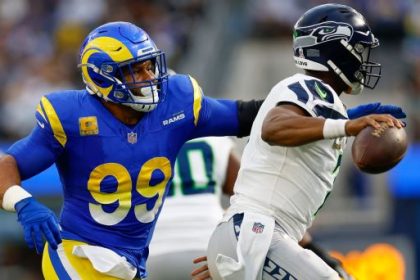
ORCHARD PARK, N.Y. — After Sean McDermott got a win in his first game as an NFL head coach, a 20-12 victory over the New York Jets in the 2017 season opener, longtime defensive tackle Kyle Williams tossed a game ball to the latest in a long recent line of Buffalo Bills coaches. The franchise, in the midst of a 17-year playoff drought — the longest in American pro sports history — had seen a lot of personalities come and go.
“First win. In the division. Many more,” Williams said.
Williams words have proved true. McDermott has led the Bills to 64 wins since he was plucked from coach Ron Rivera’s defensive staff with the Carolina Panthers. He paired well Brandon Beane, whom the Bills hired just prior the 2017 season to be the general manager after 19 seasons with Carolina.
In the six seasons since, the Bills have developed into a consistent contender.
“I had never been to the playoffs prior to me being here,” said safety Jordan Poyer, who joined the Bills as a free agent in 2017 after four seasons with the Philadelphia Eagles and Cleveland Browns. “And so, like I said, to be here, this is my sixth year here, and going to the playoffs five years, it is extremely special.”
But before they get to the postseason, the Bills have a crucial Monday night game against the Cincinnati Bengals (8:30 p.m. ET, ABC/ESPN/ESPN2/ESPN+). The 23 combined wins between the two teams is tied for the most entering a Monday night matchup. The result will go a long way toward determining the top playoff seeding in the AFC. If the Bills win their final two games, they will be No. 1.
Buffalo has gone from having the longest playoff drought to controlling its own destiny for the top seed in six seasons. How did this team come together and how long can it realistically contend with this core of players?
“Most guys have a chip on their shoulder, like we weren’t always the golden child,” left tackle Dion Dawkins said of the Bills’ roster. “I was thinking like, we don’t have no Alabama guys, we don’t have none of that superstar stuff. … It’s just like we have a lot of underdogs. A lot of underdogs create a giant dog.”
SHAQ LAWSON SPENT the first four years of his career in Buffalo after he was drafted in the first round in 2016. The defensive end left in 2020 to sign a three-year, $30 million deal with the Miami Dolphins.
But Lawson’s time away from the Bills was short-lived. He re-signed with Buffalo this offseason thanks in part to the improved culture.
“Watching [the Bills] last year, watching those guys playing, it’s like, ‘All right, I’ll come back here. It’s something special,'” Lawson said. “… Coach McDermott changed the culture so good, and it’s just been nothing but winning. … So seeing that grow from as a rookie to going on my seventh year in the league, man, it’s just something you want to be a part of.”
When McDermott started coaching the Bills, he prioritized setting a standard and showing what the expectations would be early. It’s what he saw when he coached under Andy Reid with the Philadelphia Eagles. McDermott said, in addition to knowing more now than he did when he started as a head coach, the trust built between the players and the coaching staff has allowed for more player involvement and adjustments in how things are done.
“Once [McDermott] kind of implanted his guys and were able to kind of, I wouldn’t say slightly take the reins, I guess a little bit, and let the players lead,” quarterback Josh Allen said. “He’s been so awesome in that aspect and again, just the changes in how we meet and how we talk to each other, it all starts from him. But the trust that he has in us, it’s infectious and the guys really appreciate it.”
What the Bills have created under the Beane-McDermott regime is a prime example of roster building for prolonged success. The team has been completely turned over since McDermott and Beane took over with an emphasis on drafting and developing players and re-signing its own. On the team’s roster, 49.1% (26 of 53) of players were drafted by the Bills, the ninth-most homegrown players in the league.
The team was quick to move on from players on the 2016 roster; four were on the 2019 team and one is around today in Lawson.
Most of the Bills’ foundational players came through the draft, but they’ve made savvy free agent additions as well. In 2017, the Bills brought in free agent safeties Micah Hyde (injured reserve) and Poyer, who have become leaders on a defense that has seen significant change, especially up front. Cornerback Tre’Davious White, Dawkins and linebacker Matt Milano were all drafted that year and are now on their second deals with the team.
“Me, Milano and Tre, we’re energy guys, like, we’re personalities,” Dawkins said. “We bring a lot like to this team. And I know, myself, personally, I take it with so much pride and so much respect that I was one of the first ones. But I think that we were, not smaller pieces, but we were the pieces that were needed.”
White, a 2019 All-Pro who is returning to form following 2021 ACL surgery on his left knee, and Milano, who is often overlooked as a top linebacker, have become defensive cornerstones. Dawkins, a 2021 Pro Bowler, provided the offense much-needed stability at left tackle position, the protector of the quarterback’s blind side. But in 2018, the Bills were still searching for that franchise quarterback.
They went all-in to do that in the draft, first trading up from No. 21 to No. 12 and then on draft night moving up to No. 7 in a trade with the Tampa Bay Buccaneers. Quarterbacks Baker Mayfield and Sam Darnold were already off the board, leaving the Bills their choice between Josh Rosen, Allen and Lamar Jackson, among others. The Bills chose Allen out of Wyoming at No. 7.
Buffalo took Allen despite concerns about his accuracy (completed 56.2% of passes in college) and the level of competition he faced in the Mountain West conference. But the Bills believed he was the right fit, considering his physical abilities, competitiveness, intelligence and chip he had on his shoulder. The team placed him in a stable environment, working with the same offensive coordinator (now-New York Giants head coach Brian Daboll) for the first four years of his career.
“It was just a match that was made to work,” Allen said. “Me being in this great city here in Buffalo and kind of trying to embody what the city is: blue-collar, hardworking, don’t complain, like, figure-it-out mentality. I’m very internally driven and I’ve always had this goal of mine to play this game for as long as I can.”
It was the start of Beane’s most successful draft, also featuring linebacker Tremaine Edmunds, nickel corner Taron Johnson and special teams player/corner Siran Neal.
“Most of us on this team were drafted in the ’18 class,” Neal said. “We are leaders who lead by example. It ain’t much to talk about, we know we got to do, and you got one hell of a one at quarterback, he’s that boy.”
With cornerstone players in place at some of the most difficult positions to fill — quarterback, left tackle and shutdown corner — the Bills looked to add players who could put them over the top.
This offseason, they added pass-rusher Von Miller to a $120 million deal to be a difference-maker in must-win games. He made an impact early and often in 12 games before he was lost for the season because of a right knee injury.
Perhaps the most impactful move was adding a No. 1 receiver for Allen in 2020 by trading a first-round pick and more for Stefon Diggs. Similar to Ja’Marr Chase for Joe Burrow, Diggs has been a key component of Allen’s success since 2020, fourth in receiving yards (4,085) and sixth in receiving touchdowns (28) since then.
“All I can say is what got us to this point was work ethic and having that sincere and genuine and, that real relationship,” Diggs said. “Not the one that you see on TV. The one that, I’m saying, you’ve really got somebody to back you. … Quarterback and receiver, that’s one of the best relationships you can have.”
THE BILLS AREN’T copying the Los Angeles Rams‘ trade-heavy approach to winning a title. This isn’t an all-in kind of situation.
“I want to get to the Super Bowl every year, but we can win the Super Bowl this year and we’re going to be fighting like hell to get back there next year,” Beane said prior to the season. “No move we made this year was an all-in, you better do it now. Like we’ve got a plan and we’re going to stay competitive. That’s the plan … I don’t know a case where I’m going to say, ‘Let’s push all our chips to the plate and to the table and let’s do it all right now, and don’t worry about the next year.’ That’s not what we’re doing. I promise you.”
What does the future of this team look like?
During training camp in 2021, the Bills signed Allen to a six-year extension worth $258 million with $150 million guaranteed. Allen’s deal came after he put together an MVP-caliber season in 2020, improving his completion percentage from 58.8% in 2019 to 69.2%.
After signing the deal, Allen’s cap hit for 2021 was reduced to $16.4 million after a cap hit of just over $10 million in 2020. Those smaller cap numbers allowed the Bills greater flexibility in building the roster.
But the impact of the deal will start to really be felt in 2023, when Allen will account for almost $40 million in the Bills’ cap space. That number will increase the following two years, as the cap is also expected to do. But what Allen is due will have an impact on the rest of the Bills’ roster.
A majority of the Bills’ key contributors are under contract for 2023, but there will be significant decisions to be made, especially on defense. Edmunds and Poyer are both scheduled to become free agents. While Edmunds is lacking some of the splash plays the Bills were hoping for, he is instrumental to the defense. Poyer requested a contract extension this offseason, but there was no agreement. While he had his first Pro Bowl season this year, the 31-year old has had a variety of injuries, missing four games this season.
On offense, starting running back Devin Singletary is set to become a free agent and team will need to add depth at wide receiver, which has been lacking this year, and at interior offensive line.
Per ESPN’s Roster Management, the Bills have the 10th-least available cap space next year. While the cap is expected to go up for all teams, the Bills will have many holes to fill and plenty of players on pricey contracts to pay. Keeping the core together will get harder.
But for now, the goal remains as high as ever, and that continues in a big way in Cincinnati.
“We just take it one game at a time,” McDermott said when asked about what the Bills have built. “I appreciate what you’re saying. I really do. Now’s not really the time for us on the inside — and you’ve got to be careful of that, the relaxation syndrome. You got to stay on it, you’ve got to stay urgent in your approach, put in the work that’s necessary to win.”












